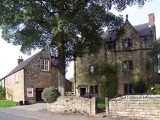
Kirk Ireton
Encyclopedia
Kirk Ireton is a village in Derbyshire
, England
. It is located 4 miles south of Wirksworth
nestling on a hillside, 700ft above sea level. Ireton is a corruption of Hyre-Tun in the Saxon and means 'The Irishman's Enclosure'. 'Kirk' was added after the Norman invasion and the building of the church. The village dates back at least as far as the Bronze Age.
One of the oldest buildings in the village is the Barley Mow pub, which was one of the last premises in the country to accept decimalization, as the 87 year old landlady, Mrs Lillian Ford did not hold with the new money. The parish previously housed at least four other public houses; The Wheatsheaf, The Bull's Head, The Windmill and The Gate.
Kirk Ireton's Holy Trinity Church (originally St Lawrence's) dates back to Norman times with the earliest parts being the 3 bayed south and north arcades. The tower and the chancel are Perpendicular. It has an interesting custom known as 'roping for weddings', when the village children put a rope across the road and the bride and groom are not allowed to leave the church until a toll has been paid in silver by the groom.
The village still celebrates a Wakes week
, which starts on Trinity Sunday
, the church's patronal festival. A procession of villagers is led by a local brass band, from the Barley Mow pub to the church for thanksgiving.
The Post Office (as pictured) was closed at the beginning of 2008. It is now (2010) open as a community shop. The premises were originally stables and the restored hay racks are, to the delight of visitors, still in place above shelving along one wall.
Derbyshire
Derbyshire is a county in the East Midlands of England. A substantial portion of the Peak District National Park lies within Derbyshire. The northern part of Derbyshire overlaps with the Pennines, a famous chain of hills and mountains. The county contains within its boundary of approx...
, England
England
England is a country that is part of the United Kingdom. It shares land borders with Scotland to the north and Wales to the west; the Irish Sea is to the north west, the Celtic Sea to the south west, with the North Sea to the east and the English Channel to the south separating it from continental...
. It is located 4 miles south of Wirksworth
Wirksworth
Wirksworth is a small market town in Derbyshire, England, with a population of over 9,000.The population of the Wirksworth area including Cromford, Bolehill and Middleton-by-Wirksworth is about 12,000. Wirksworth is listed in the Domesday Book in 1086. Within it is the source of the River...
nestling on a hillside, 700ft above sea level. Ireton is a corruption of Hyre-Tun in the Saxon and means 'The Irishman's Enclosure'. 'Kirk' was added after the Norman invasion and the building of the church. The village dates back at least as far as the Bronze Age.
The village
Kirk Ireton remains what it has always been, an agricultural village. Following the Second World War the number of working farms dropped from over thirty to half a dozen in the space of 40 years. The last cow was turned down Main Street in the late 1980s, but Fords, Matkins, Rowlands, Walkers and Wards still farm locally as they have done for many generations. Many of the former farm buildings have been adapted into houses. Much of the older part of the village dates back to the 17th century and is mostly built from sandstone, quarried locally.One of the oldest buildings in the village is the Barley Mow pub, which was one of the last premises in the country to accept decimalization, as the 87 year old landlady, Mrs Lillian Ford did not hold with the new money. The parish previously housed at least four other public houses; The Wheatsheaf, The Bull's Head, The Windmill and The Gate.
Kirk Ireton's Holy Trinity Church (originally St Lawrence's) dates back to Norman times with the earliest parts being the 3 bayed south and north arcades. The tower and the chancel are Perpendicular. It has an interesting custom known as 'roping for weddings', when the village children put a rope across the road and the bride and groom are not allowed to leave the church until a toll has been paid in silver by the groom.
The village still celebrates a Wakes week
Wakes week
The wakes week is a holiday period in parts of England and Scotland.- History :Wakes were originally religious festivals that commemorated church dedications...
, which starts on Trinity Sunday
Trinity Sunday
Trinity Sunday is the first Sunday after Pentecost in the Western Christian liturgical calendar, and the Sunday of Pentecost in Eastern Christianity...
, the church's patronal festival. A procession of villagers is led by a local brass band, from the Barley Mow pub to the church for thanksgiving.
The Post Office (as pictured) was closed at the beginning of 2008. It is now (2010) open as a community shop. The premises were originally stables and the restored hay racks are, to the delight of visitors, still in place above shelving along one wall.
Notable residents
- Anthony BlackwallAnthony BlackwallThe Reverend Anthony Blackwall , was an English classical scholar and schoolmaster.-Early life:...
- scholar was born here. - George TurnerGeorge Turner (artist)George Turner was an English landscape artist and farmer who has been dubbed "Derbyshire's John Constable".-Life and work:Turner was born in Cromford, Derbyshire in England, but then moved to Derby with his family...
(1841-1910), landscape artist, lived at the Barley Mow Inn from 1900 to his death in 1910.

